- What is Docker Engine?
- How Does Docker Engine Work?
- The Benefits of Using Docker Engine
- Related articles:

Docker has revolutionized the world of software development and deployment with its efficient and easy-to-use containerization technology. At the heart of Docker's functionality is the Docker Engine, a powerful tool that enables the creation, management, and running of containers. In this article, we will explore the capabilities of Docker Engine and how it simplifies the process of containerization.
What is Docker Engine?
Docker Engine is the core component of the Docker platform, responsible for building, running, and managing containers. It is essentially a lightweight runtime and toolset that allows you to create and run containers on any system. Docker Engine provides the necessary tools to package your application with all its dependencies into a standardized unit, known as a container. These containers are isolated from the underlying system and can run on any machine, eliminating the notorious "works on my machine" problem.
With Docker Engine, you can easily build, deploy, and scale applications using containers, enabling faster and more efficient development workflows. It abstracts away the complexities of the underlying infrastructure, making it easier for developers to focus on writing code rather than worrying about dependencies, configurations, and compatibility issues.
How Does Docker Engine Work?
Docker Engine consists of three key components: the Docker daemon, the Docker client, and the Docker image registry. Let's take a closer look at each of these components:
-
Docker Daemon: The Docker daemon, also known as
dockerd, runs as a background service on a host machine. It manages the creation, execution, and monitoring of containers. The daemon listens for Docker client commands and carries out the requested actions, such as starting or stopping containers, pulling or pushing images, and managing networks and volumes. -
Docker Client: The Docker client,
docker, is a command-line interface (CLI) tool that communicates with the Docker daemon. It allows users to interact with the Docker Engine and perform various operations, such as building, running, and managing containers. The Docker client can be used locally on the host machine or remotely to connect to a Docker daemon running on a different machine. -
Docker Image Registry: Docker Engine utilizes a distributed image registry to store and distribute container images. The default registry, Docker Hub, hosts a vast collection of pre-built images that can be pulled and used to run containers. Additionally, you can create and publish your own images or use private registries for more controlled access to your container images.
The Benefits of Using Docker Engine
Docker Engine offers several advantages that have made it the de facto standard for containerization:
-
Portability: Containers created with Docker Engine are highly portable, allowing them to run consistently on any system, regardless of its underlying architecture or operating system. This portability is achievable due to Docker's use of containerization technologies, such as namespaces, cgroups, and Union File Systems.
-
Efficiency: Docker Engine maximizes resource utilization by running containers directly on the host machine's operating system, without the need for a separate guest operating system. By sharing the host's kernel, containers are lightweight and require minimal resources, resulting in efficient allocation of system resources.
-
Isolation: Docker Engine provides strong isolation between containers and the host system, ensuring that any changes made within a container do not affect the host or other containers. This isolation enables developers to create reproducible and independent environments for their applications, reducing compatibility issues and conflicts between dependencies.
-
Scalability: Docker Engine allows you to easily scale your applications by orchestrating multiple containers using tools like Docker Swarm or Kubernetes. These tools enable the management of container clusters, load balancing, and automatic scaling, empowering you to handle increased traffic and workloads seamlessly.
-
Flexibility: With Docker Engine, you have the flexibility to work with a wide range of frameworks, programming languages, and tools. Whether you're developing a microservices-based architecture, deploying scalable web applications, or running complex data processing pipelines, Docker Engine can adapt to your specific needs.
Related articles:
-
Introduction To Containerization - Learn more about the fundamentals of containerization and its benefits.
-
What Is Docker - Dive deeper into the concept and capabilities of the Docker platform.
-
Docker Compose: Simplifying Container Deployment - Explore the use of Docker Compose to streamline the deployment of multi-container applications.
-
Docker Swarm: Managing Container Clusters - Discover how Docker Swarm simplifies the orchestration and management of Docker container clusters.
-
Kubernetes Vs Docker Swarm: Which Container Orchestration Platform is Right for You? - Compare the two popular container orchestration platforms, Kubernetes and Docker Swarm, to choose the best fit for your needs.
In conclusion, Docker Engine empowers developers to harness the power of containerization, enabling them to build, deploy, and scale applications with ease. Its simplicity, efficiency, and portability make it an indispensable tool for modern software development and deployment workflows. By incorporating Docker Engine into your workflow, you can unlock new levels of productivity and efficiency in your application development and deployment processes.
